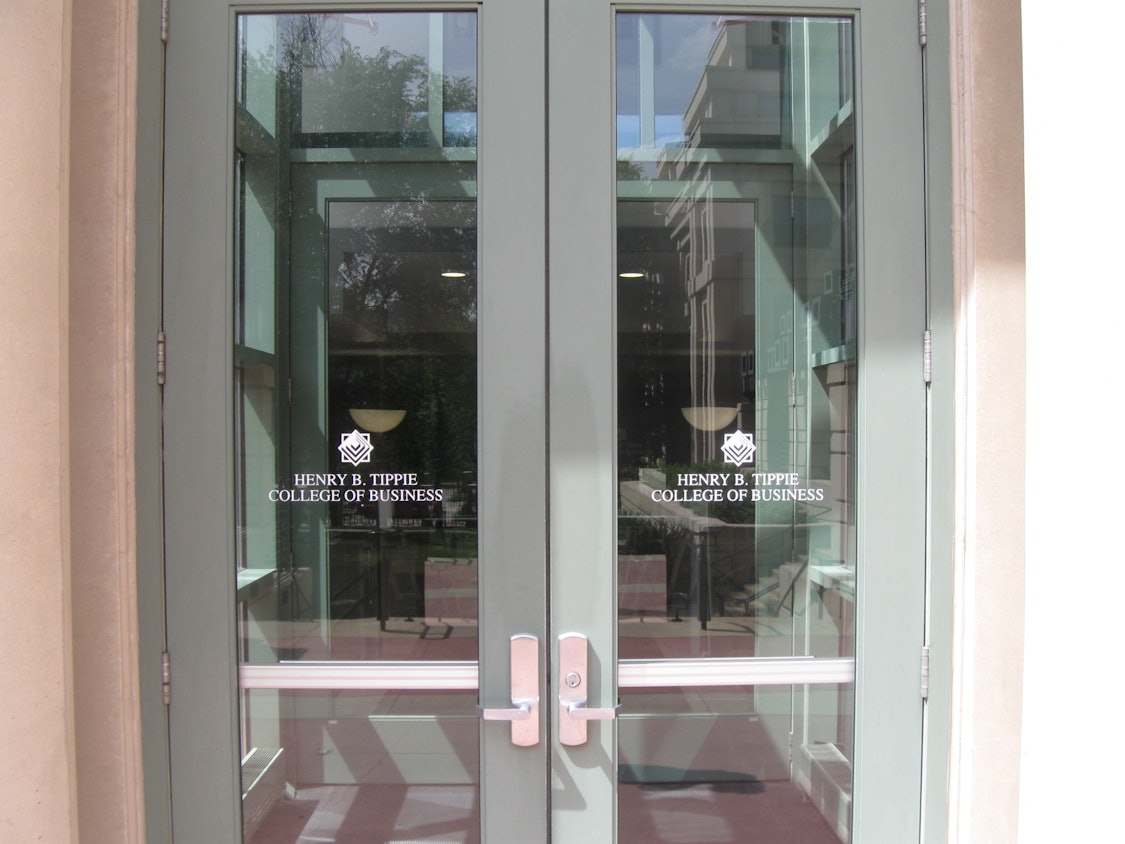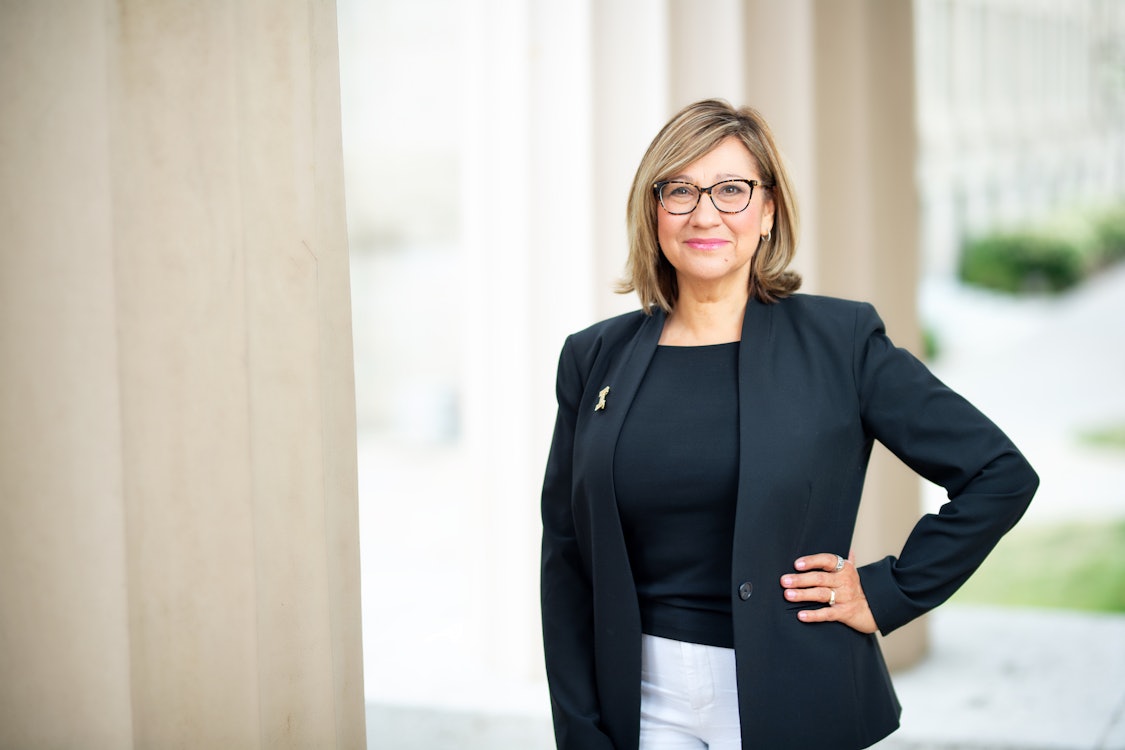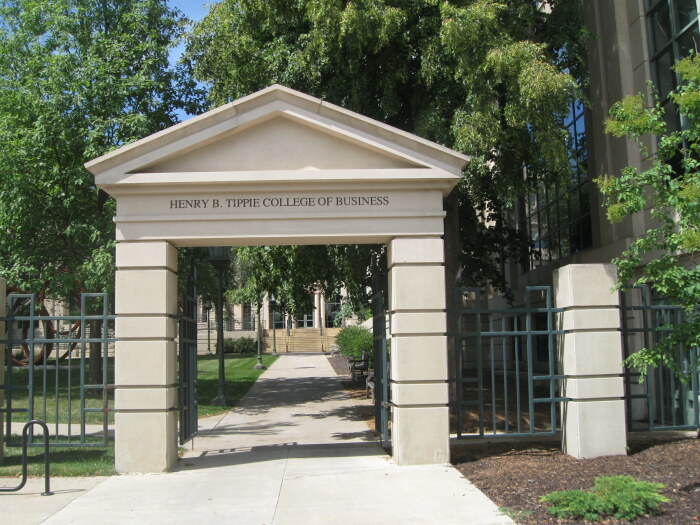John Morrissey is a freelance writer in Des Moines.
Sharp-eyed readers may have noticed this summer that the University of Iowa’s Henry B. Tippie College of Business has signed on as a sponsor of the 6 pm newscasts on KCCI-TV 8 and WHO-TV 13. Those viewers may also be mystified about why the ads are running
The business school has placed 15-second sponsorship ads during the Des Moines television newscasts along with radio, print, billboard, and digital ads in order to reintroduce the Tippie College of Business to central Iowans, College Dean Amy Kristof-Brown told Bleeding Heartland.
“The Tippie College of Business is an important part of the Central Iowa community but a lot of people who live there don’t realize that because the main campus is a couple of hours down the road in Iowa City,” she wrote in response to written questions. “The primary goal of this campaign is to make people more aware of our presence and understand the important role we play in workforce development in the region.”
SCHOOL WON’T RELEASE DETAILS ON AD CAMPAIGN
Kristof-Brown, also a professor of Management and Entreprenuership at the college, declined to specify the other media outlets involved, the budget for the program, or how many ad spots would comprise the campaign. Private donor funds financed the ad buy, and the video uses stock images the University of Iowa already owned.
According to a 2022 KCCI-TV media guide, about 170,000 Iowans see the 6 pm newscasts on channels KCCI-TV 8 and WHO-TV 13, and 193,000 see the 10 pm news on those stations. The 35-county broadcast area for Des Moines-based stations has a population of 859,000 people age 18 and older.
Recent TV spots feature the College’s new risk management and insurance undergraduate degree and postgraduate programs. “These new offerings will equip students with a solid educational grounding in insurance and enable them to start work supporting and strengthening Iowa’s largest non-agricultural economic sector as soon as they graduate,” Dean Kristof-Brown wrote.
“Sharing specific details about the phases of the campaign, target markets, and budget would put us at a competitive disadvantage to our peers,” said Rebekah Tilley, Director of Strategic Communications for the University’s business school.
“The purpose of the ad campaign is simply to build the college’s reputation as the #1 business school in Iowa,” Tilley said. “We of course want our alumni to see our ads, but sharing the details you are requesting would be information that is also of interest to competing universities,” she explained.
The school’s internal marketing team developed the campaign and is “focused on brand awareness rather than a specific product offered by the Tippie College of Business,” she said. “As we offer new curriculum, it is important for our overall brand to be strong.”
The Tippie College of Business is “in the process of launching our new undergraduate risk management and insurance major and graduate risk management and insurance certificate,” Tilley said. “Des Moines is a national insurance hub and these programs can serve as a workforce pipeline to the insurance industry. A marketing campaign centered on building our brand reputation is part of our recruitment strategy.”
Fortune magazine recently listed the school’s online MBA program as the 8th best of 100 programs ranked across the country.
SHOULDER SHRUG ABOUT COLLEGE AFFORDABILITY
“Access and affordability are always at the top of our considerations when we make any decision,” the dean wrote to Bleeding Heartland. The University of Iowa annually provides about $118 million in financial aid and Tippie students are the recipients of more than $14.4 million of that assistance. On top of that, Tippie students received more than $2.7 million in additional aid from private donors and other sources during the previous fiscal year. “And we’re always looking for opportunities to make more aid available,” she added.
In June, the Iowa Board of Regents approved 3.5 percent tuition increases at the three state universities for the coming year. That comes on the heels of a 4.25 percent increase last year. The regents have approved tuition hikes more frequently over the past two decades because of cost shifting by the Iowa legislature. The percentage of total university system funding from tuition has soared from 30 percent in 2001 to 63 percent today. Meanwhile, the state’s general fund share of university funding has slipped from 63 percent in 2001 to just over 30 percent this year.
The dean was non-committal when asked specifically about a “last dollar” tuition grant program focused on Tippie College graduates, which would ensure that no graduate of the college leaves with tuition debt. “We work hard to keep tuition low, too, even as state appropriations don’t match inflation and students take on a greater share of the expenses,” Kristof-Brown wrote. “We want to make sure Tippie students have access to a great business education that’s affordable.“
She noted that tuition at the University of Iowa is among the lowest in the state. “The university also remains one of the most affordable options for students in its peer group and the Big Ten, costing about $3,000 less per year than the Big Ten average.”
About half of University of Iowa students graduate with no debt, she wrote, which is less than the national average. “Of those who do take out loans, the average debt is about $29,000, also below the national average.”
MINNESOTA’S PROGRAM TO BOLSTER HIGHER EDUCATION
While University of Iowa officials buff the faded gold leaf of their reputation, a neighboring state has adopted a plan to provide tuition-free post-secondary education to many of its residents.
In May the Minnesota legislature passed the North Star Promise scholarship program. North Star provides “last dollar” financing for students attending Minnesota colleges and universities, including private schools and community colleges. The financial assistance is open to families earning no more than $80,000 per year, and will provide tail-end funding after all other state and federal financial assistance to a student is calculated.
Iowa’s “last dollar” tuition awards, adopted in 2018, are focused on Future Ready vocational programs offered by eighteen Iowa community colleges and health sciences schools. The 2025 Future Ready goal is for 70 percent of Iowans to have obtained education and training beyond high school.
Only certain Iowa community college courses of study are eligible: 374 associate degree programs, 255 Career & Technical Education diplomas, and 130 certificate programs are currently listed as eligible. Governor Kim Reynolds’ 2024 budget request included nearly $24 million to fund the program. Information about the program’s applicability to four-year programs is currently unavailable due to several broken links on the state’s webpages.
The Minnesota program is estimated to cost $117 million beginning with the fall semester of 2024, due to start-up costs, and $49.5 million annually after that. Minnesota education officials estimate between 15,000 and 20,000 students may qualify for assistance.
The Minnesota program has given neighboring North Dakota university officials the willies. Irina Ivanova reported for the Associated Press that North Dakota’s post-secondary system would experienced an $8.4 million loss in combined tuition and fees in the first year alone. About 1,400 students from Minnesota attend North Dakota colleges.
NO STUDENT INVOLVEMENT IN TIPPIE’S AD CAMPAIGN
One of the odd aspects of the Tippie College of Business campaign is that the ads don’t feature any enrolled students. (Writer’s note: After this article was written, the university rolled out new TV sponsorship commercials featuring enrolled students.) The college boasts an active chapter of the American Advertising Federation (AAF), but Tilley said they didn’t assist with this campaign.
A website for the university’s chapter of the AAF says the group
strives to create an experience-oriented learning environment for students interested in pursuing a career in the advertising industry. By interacting with industry professionals and providing members with opportunities to use learned skills, AAF strives to expose its members to as many professional situations and opportunities as possible.
The AAF has 200 chapters across the country and more than 5,000 student members.
“The University of Iowa’s chapter of the AAF is an organization open to all students at Iowa, and dedicated to providing its members with educational, professional, and networking opportunities within the world of advertising!” the website states. Emails seeking comment and addressed to the chapter’s president and faculty advisor were returned as undeliverable.
The first set of TV commercials to air locally opened with the university logo and voice-over about being the number one business school in Iowa. Quick cut shots follow, providing an aerial view of the Iowa City campus with a high-level zoom in on the Pappajohn Business Building and the Pentacrest in the foreground. Remarkably absent was any evidence of students moving from building to building or even being present on campus.
The ad contains a generic website address (iowatippie.com), but no web landing page, or social media or QR code referrals. There are no obvious direct links to the brand message on the Tippie College’s main web page. The campaign does not utilize the business school’s logo, which someone went to the effort of pasting on all of the building’s exterior doors. Correction: The university maintains iowatippie.com is the landing page for for the branding campaign. In addition, the campaign features the University of Iowa’s logo, which the college also uses. The graphic image on these doors is not the college’s logo.

Photo by John Morrissey
Enrollment records produced by the university provost indicate the business school has experienced a 40 percent enrollment growth over the past decade, for both the undergraduate and graduate programs. Business undergraduates make up 15 percent of all University of Iowa undergraduates. Business graduate students comprise nearly 30 percent of the university’s graduate student population.
Facing declining student interest in its previous MBA programs, the university dropped its full time MBA program in 2019. The university offers specialized two-year MBA programs on campus, online, and at its satellite facilities in Des Moines, Cedar Rapids, and Paderma del Grappo in Italy.
Full text of John Morrissey’s Q&A with Tippie College of Business Dean Amy Kristof-Brown
A: First, you mention in your note that you’ve noticed we’re expanding our suite of online classes. That’s definitely true when it comes to our programs for working professionals, like the MBA. Working professional students have made it clear in recent years that they prefer online classes to in-person classes because of the flexibility, so we’ve been adding more online options to give them the format that they want. Professional students have jobs, families, and other commitments. Most would rather take the class at home instead of spending time driving to a classroom after working all day. They really like being able to watch lectures at a time that’s convenient for them, and then log on to the virtual class from anywhere. Almost all of our online courses have a scheduled synchronous component to allow interaction between students and the instructor. Being able to access those sessions from anywhere means no more missing classes because of work trips or vacations. The professional students have really embraced this model.
But when it comes to undergraduates, the vast majority of those classes are still offered in-person because undergraduates have told us they prefer the traditional face-to-face format. They like the social aspects of going to class, being with friends, and working closely with faculty that you get in an in-person class. If you visit the Pappajohn Business Building, you’ll find the hallways and classrooms teeming with students.
One other note is that you mention a one-year MBA in your email. We don’t actually have a one-year MBA. The Iowa MBA generally requires two years to complete. It is 15 courses, and students typically take 2-3 courses a semester and during the summer. Our other professional master’s programs include a Master of Accountancy, a Master of Finance, and a Master of Science in Business Analytics (MSBA). These programs differ in length depending on the amount of relevant coursework that students have taken before entry, but are generally less than 2 years.
Q: Why are we doing this campaign and how effective can it be?
A: The Tippie College of Business is an important part of the Central Iowa community but a lot of people who live there don’t realize that because the main campus is a couple of hours down the road in Iowa City. The primary goal of this campaign is to make people more aware of our presence and understand the important role we play in workforce development in the region. We have thousands of alumni living in the Des Moines metro area and we have about 1,500 working professionals enrolled in the Iowa MBA and Master of Science in Business Administration (MSBA) programs. Our students and faculty work with local businesses as consultants, and the John Pappajohn Entrepreneurial Center (Iowa JPEC) has helped thousands of entrepreneurs in Central Iowa get their businesses off the ground through Venture School and other programs it offers.
Demonstrating our commitment to enhancing Iowa’s workforce, we’re also undertaking a new emphasis on Risk Management and Insurance (RMI), which includes a new undergraduate major and a new graduate-level certificate for people who want more advanced studies. These new offerings will equip students with a solid educational grounding in insurance and enable them to start work supporting and strengthening Iowa’s largest non-agricultural economic sector as soon as they graduate. We also have a new partnership with Des Moines’ Global Insurance Accelerator that will give our students and faculty hands-on experience working and consulting in the insurance industry while helping Insurtech startups in the incubator grow into viable firms. And this summer we helped design and recruit a significant number of students into the Iowa Economic Development Authority’s “Insure Your Future” program, which combines insurance industry internships for early-stage students with professional development from leaders at local companies.
Frankly, I think we have a great story to tell Iowans. It’s important that they know there is a nationally recognized business school available right here in Iowa. Our ranking in U.S. News & World Report and the Iowa MBA’s ranking of 8th nationally by Fortune magazine are show that we provide programs that are of national caliber. We’re an important part of the community, and 15 seconds is enough time to share that message and spark people’s interest. If those 15 seconds also encourage a high school student to consider attending Tippie, or an alum to feel proud of their alma mater, or a business to reach out and see what kind of services we have that might help them, well, that’s great, too. It sparked your interest so there’s some evidence it’s working!
Q: Is this in memory of Henry Tippie and John Pappajohn’s memories?
A: I’d like to think everything we do is dedicated to the memories of Henry and John. We’ll always be grateful for the support they gave to us and for the inspiration they provide our students and faculty. The campaign’s primary goal is to introduce or re-introduce ourselves to Iowans. Henry’s last goal for the college was to continue to grow our reputation so that everyone in the country knows that the Tippie College of Business offers a topflight education for students and generates new knowledge that impacts the world of business. This campaign is a chance to tell people about all the great things we’re doing at the college that both Henry and John helped to build and loved so much.
Q: What are the campaign’s target markets, media mix and budget
A: We’re unable to share the dollar figure, but the campaign is a mix of digital, billboards, and radio and TV spots, and all expenses were covered by money from a private gift. No tuition or tax money was used.
Q: What about increased financial aid
A: Access and affordability are always at the top of our considerations when we make any decision. The University of Iowa annually provides about $118 million in financial aid and Tippie students are the recipients of more than $14.4 million of that assistance. On top of that, Tippie students received more than $2.7 million in additional aid from private donors and other sources in FY23. And we’re always looking for opportunities to make more aid available.
We work hard to keep tuition low, too, even as state appropriations don’t match inflation and students take on a greater share of the expenses. We want to make sure Tippie students have access to a great business education that’s affordable. Fortunately, tuition at the University of Iowa is among the lowest in the state. The university also remains one of the most affordable options for students in its peer group and the Big Ten, costing about $3,000 less per year than the Big Ten average.
These efforts pay off, too. About 50 percent of university students graduate with no debt, which is less than the national average. Of those who do take out loans, the average debt is about $29,000, also below the national average.

Photo by Justin Torner of Dean Amy Kristof-Brown
Top photo of the entrance to the Tippie college is by John Morrissey.

